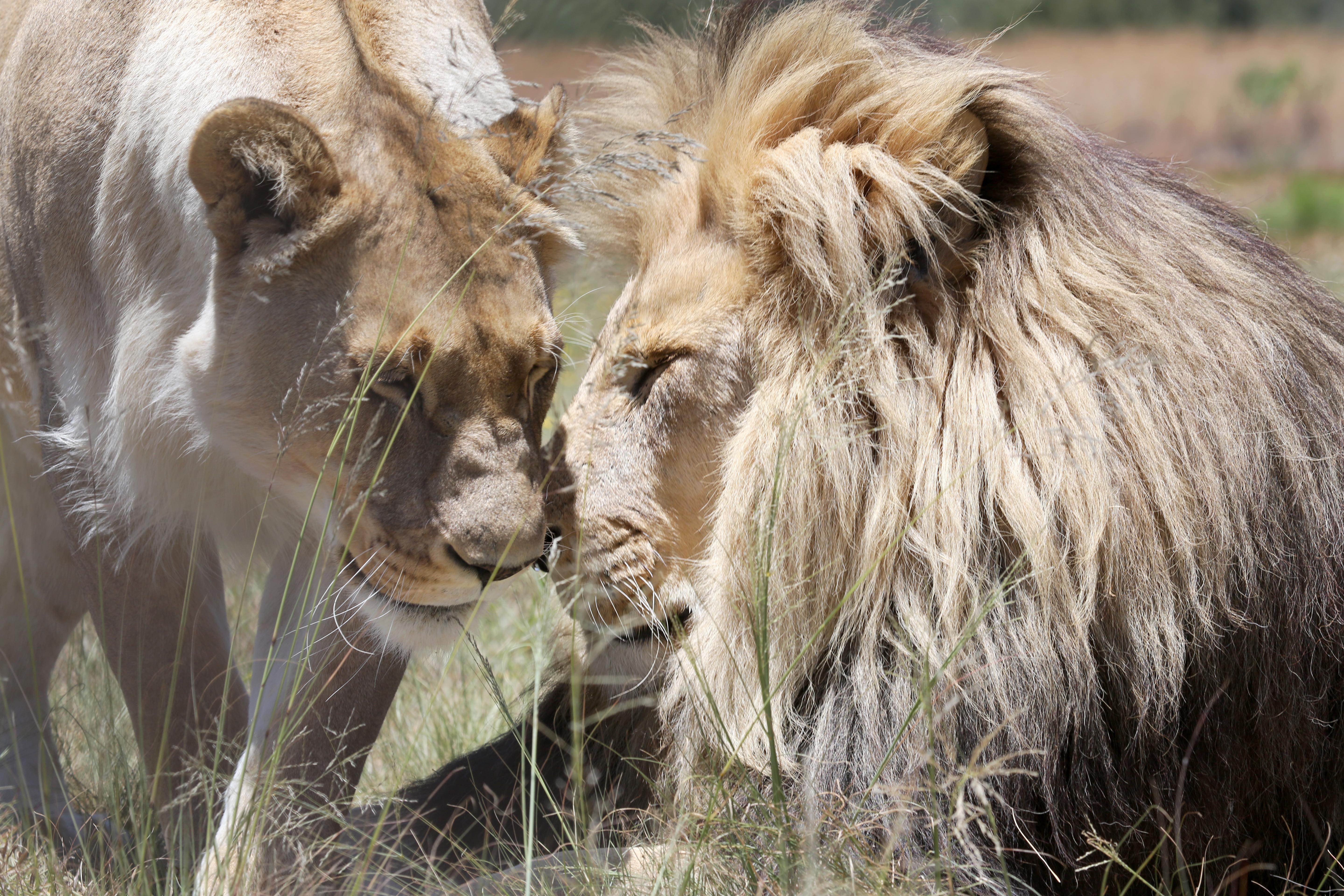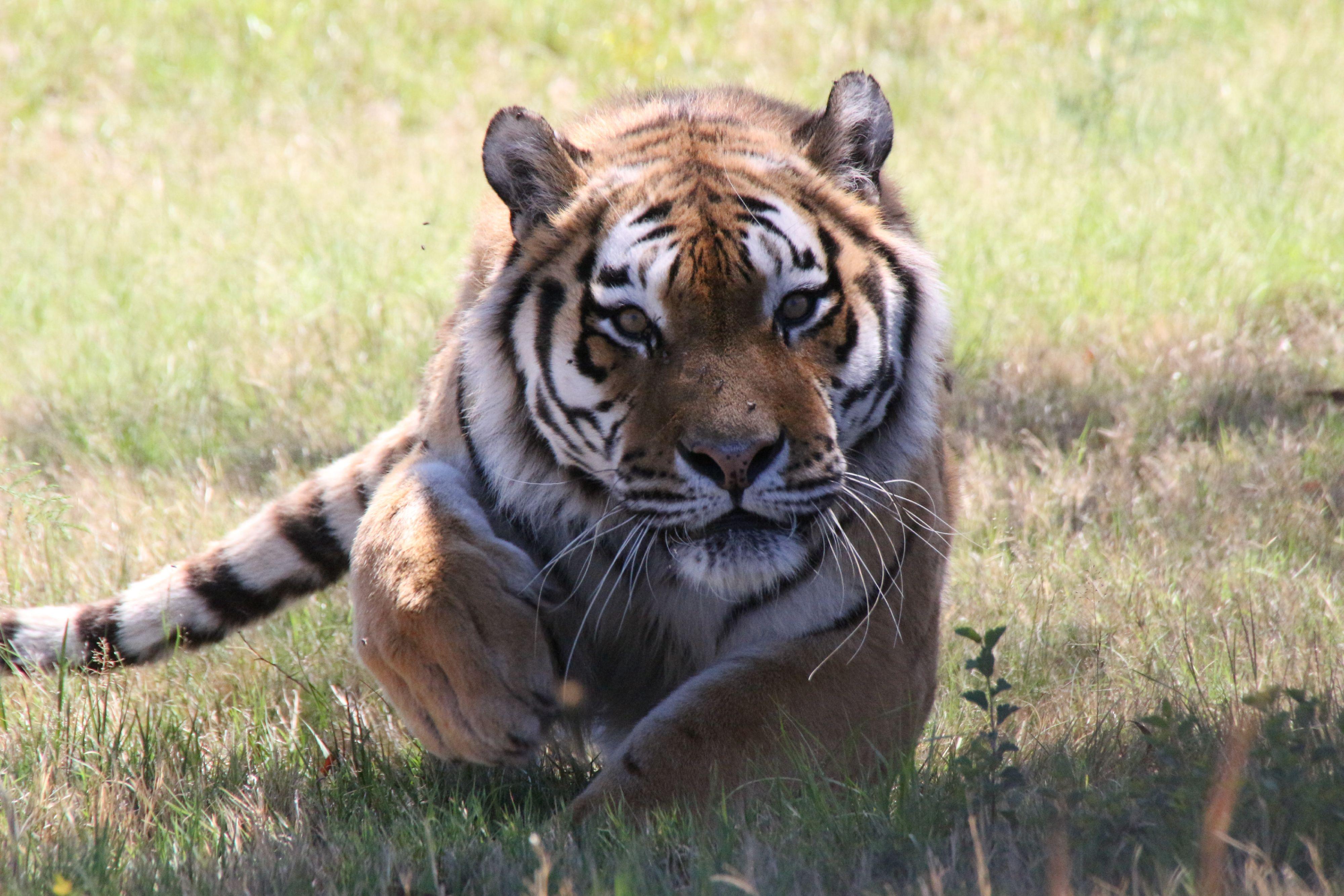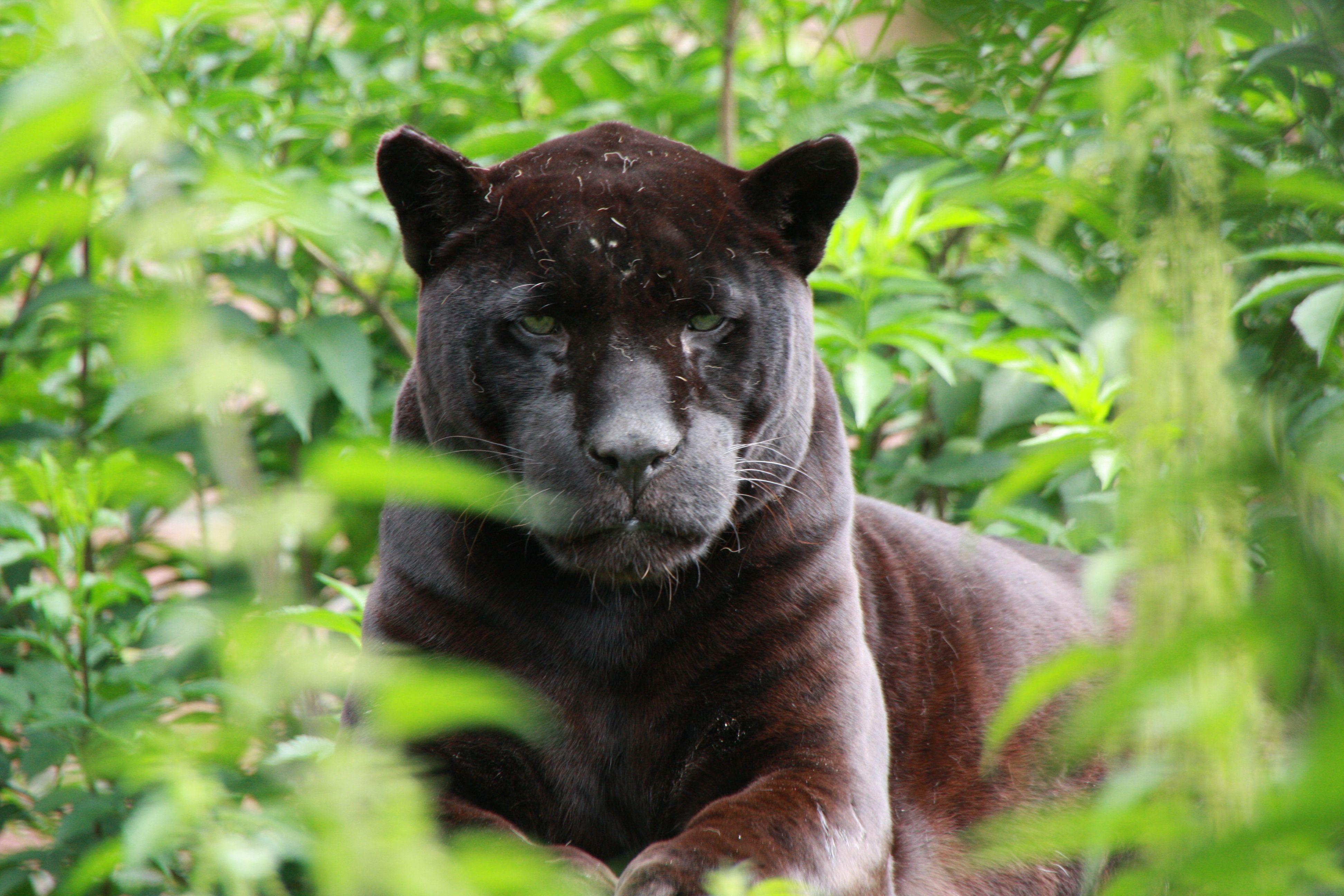|
Panthera taxonomy and phylogeny Class: Mammalia (mammals) The Felidae family consists of feline predators and can be divided into two subfamilies: the Pantherinae and the Felinae. The Pantherinae family includes the five big cat species, found within the genus Panthera: the lion (Panthera leo), tiger (Panthera tigris), jaguar (Panthera onca), leopard (Panthera pardus) and snow leopard (Panthera uncia). FOUR PAWS focuses on these big cat species. All the big cat species are declining worldwide. The main threats to big cat populations are habitat loss, human–wildlife conflict, (illegal) wildlife trade and hunting. Wild population numbers would benefit more from habitat protection than from the release of captive big cats into these environments.
A group of lionesses Lions The lion (Panthera leo) is the only true social wild big cat and is found in Africa and Asia. Prides typically consists of 1-20 related females, their offspring and 1-9 often related males (average 2-4). The females typically stay within one pride, although the entire pride is rarely all together at once. Pride cohesiveness is dependent on prey availability. The color of the coat varies from yellow-brown and grey to orange and dark brown. It is possible to identify individual lions based on their whisker spot pattern. Some lions have a white coat. These lions are not albino and are not a separate (sub)species but have a recessive mutation that results in the white skin and lighter eyes. White lions exist in the wild in the Greater Kruger in southern Africa, but they are mostly found in captivity. As the mutation is recessive and rare, most captive white lions are inbred, negatively affecting their health and welfare. White lions are often cross-eyed, which is a sign of inbreeding. P. l. persica (Asiatic lion) There is only one population of Asiatic lions, which is found in Gir National Park in India. There are plans to introduce this subspecies into Kuno Wildlife Sanctuary, with the intention to protect the subspecies from extinction due to diseases and/or natural calamities. Scientists have however proposed a different split into subspecies, which is still being researched. This split includes two subspecies, Panthera leo leo (Asia and West, Central and North Africa), and Panthera leo melanochaita (South and East Africa). Status Quick facts Maximum life expectancy: ♀19 years ♂16 years (rarely older than 12 years)Average size: body ♀158 - 192 cm ♂172 - 250 cm, tail 60 - 100 cm, shoulder height 100 - 128 cm, weight: ♀110 - 168 kg ♂150 - 272 kg Sexual mature: ♀ 30 - 36 months, but often first give birth at around 42 - 48 months ♂ 26 - 28 months Gestation period; litter size; weaning; dispersal age: 98 - 115 days; 2 - 4 up to 7; 6 - 8 weeks, but may continue until 8 months; rarely before 2 years CITES: Appendix I (Asia) & II (Africa) IUCN Red List: Vulnerable (global); Endangered (India); Critically endangered (West Africa) Population trend: Decreasing
The lion (Panthera leo) is the only true social wild big cat and is found in Africa and Asia. Tiger The tiger (Panthera tigris) is a solitary big cat species and is known to be the biggest big cat in the wild, although sizes do vary from 309 lbs to up to 575 lbs. The largest tiger in captivity weighed 717 lbs. The basic color of the coat varies from dark red to pale yellow and the pattern and darkness of the stripes vary. In general, tigers from northern regions are lighter with fewer stripes. The coat is short, except for the thick, long winter fur in far eastern Russian regions. The patterns on the flanks and the head are unique per individual. Some tigers have a white coat. These tigers are not albino and are not a separate (sub)species but have a recessive mutation that results in the white skin. White tigers are rarely recorded in the wild and are mostly found in captivity. As the mutation is rare and recessive, most captive white tigers are inbred, negatively affecting their health and welfare. White tigers are often cross-eyed, which is a sign of inbreeding. P. t. tigris (Bengal tiger) found in Indian sub-continent; Endangered P. t. amoyensis (South China tiger) this species has not been directly observed in the wild since the 1970s, so is possibly extinct; Critically endangered P. t. corbetti (Northern Indochinese tiger) found in Indochina north of the Malayan Peninsula; Endangered P. t. jacksoni (Malayan tiger) found in Peninsular Malaysia; Critically endangered P. t. sumatrae (Sumatran tiger) found in Sumatra; Critically endangered P. t. balica (bali tiger) used to be in Bali; Extinct P. t. sondaica (Javan tiger) used to be in Java; Extinct P. t. virgate (Caspian tiger) used to be in dry river valleys of the Takla Makan, western slopes of the Tianshan mountains, Amudarya and Syrdarya river valleys, shores of the Caspian Sea, Elburz mountains, eastern Turkey, Tigris and Euphrates river valleys; Extinct There are however varied opinions regarding the interpretation of the existing data used to divide tigers into the different subspecies. Hence, this taxonomy is currently under review by the IUCN SSC Cat Specialist Group. Status Hunting behavior Average size: body ♀146-177 cm ♂189-300 cm, tail 72-109 cm, shoulder height 80-110 cm, weight ♀75-177 kg ♂100-261 kg Sexual mature: 2.5-3 years; earliest breeding ♀3 years and ♂ 3.4 years Gestation period; litter size; weaning; dispersal age: 95-107 days; 2-5; 3-5 months; 17-24 months CITES: Appendix I IUCN Red List: Endangered (global) Population trend: Decreasing
The tiger (Panthera tigris) is a solitary big cat species and is known to be the biggest big cat in the wild. Leopard The leopard (Panthera pardus) is a very tolerant species, which can persist in many different habitats. They are known to be able to survive in high human densities. Additionally, they can cope with extremely cold temperatures (-22 °F in Russian boreal forests) and extremely hot temperatures (158 °F in deserts). Leopards are solitary and extremely territorial. The coat color varies from bright golden yellow to pale yellow and rust red yellow, with a white belly. The coat is short with black spots on the head, neck, shoulders, legs and backside. On the side and the back, the black spots form broken circles or rosettes. Melanistic forms, known as black leopards or black panthers, also occur. Taxonomy and distribution P. p. nimr (Arabian leopard) Arabia P. p. saxicolor (Persian leopard) Southwest Asia P. p. melas (Javan leopard) Java P. p. kotiya (Sri Lankan leopard) Sri Lanka P. p. fusca (Indian leopard) Indian sub-continent P. p. delacouri (Indochinese leopard) Southeast Asia into Southern China P. p. japonensis (North Chinese leopard) Northern China P. p. orientalis (Amur leopard) Russian Far East, Korean Peninsula and northeastern China The taxonomy for P. pardus is currently under review by the IUCN SSC Cat Specialist Group. For some subspecies there are population estimates available: Amur Leopard (P. p. orientalis) - Critically Endangered: < 60 Arabian Leopard (P. p. nimr) - Critically Endangered: 45-200 Javan Leopard (P. p. melas) - Critically Endangered: 350-525, with < 250 mature breeding adults Sri Lankan Leopard (P. p. kotiya) - Endangered: 700-950 Persian Leopard (P. p. saxicolor) - Endangered: 800-1,000 Hunting behavior Average size: body ♀95-123 cm ♂91-191 cm, tail 51-101 cm, shoulder height 55-82 cm, weight: ♀17-42 kg ♂20-90 kg Sexual mature: 24-28 months, with females given birth for the first time at the age of 30-36 months and males first breeding at around 42-48 months Gestation period; litter size; weaning; dispersal age: 90-106 days; 1-4, rarely to 6; 8-10 weeks and ceased before 4 months; 12-18 months CITES: Appendix 1 (with existing hunting quotas) IUCN Red List: Vulnerable (global) Population trend: Decreasing
The leopard (Panthera pardus) is a very tolerant species, which can persist in many different habitats. Jaguar The jaguar (Panthera onca) is a solitary species. Jaguars are territorial but overlap occurs frequently. The jaguar is the third largest cat in the world, but the largest cat of the Americas. However, sizes vary greatly. Smaller jaguars can be found in Central America, while jaguars double this size can be found in the wet woodland savannah habitats in Venezuela and Brazil. It is the only Panthera species that lives in the New World. The basic color of the coat varies from pale gold to a rust red and is covered with a series of round dark spots or rosettes with smaller dots within them (unlike leopards). Black (melanistic) jaguars, also referred to as black panthers, are common. Taxonomy and distribution Status Hunting behavior Quick facts Maximum life expectancy: poorly known from the wild, but thought not to exceed 15-16 yearsAverage size: body ♀116-219 cm ♂110-270 cm, tail 40-80 cm, shoulder height 68-75 cm, weight: ♀36-100 kg ♂36-158 kg. Sexual mature: 24-30 months, with females given birth for the first time at the age of 3-3.5 years old Gestation period; litter size; weaning; dispersal age: 91-111 days; 1-4; 10 weeks, but typically ceases after 4-5 months; 16-24 months CITES: Appendix I IUCN Red List: Near Threatened Population trend: Decreasing
The jaguar (Panthera onca) is a solitary species. Jaguars are territorial but overlap occurs frequently. Snow leopard The snow leopard (Panthera uncia) is a solitary species, found in high mountain habitats. Snow leopards keep a stable large home range, but it is unknown whether this home range is defended as a territory. Snow leopards are adapted to cope with deep snow, rugged terrains and high altitudes. Due to the distribution and habitat use of snow leopards, they are extremely difficult to study and very little is known about this species. The basic color varies from smoke grey to tan, with a white belly. Covered with dark grey to black open rosettes with small spots of the same color on the head and larger spots on the legs and tail. Snow leopards have pale green or grey eyes, which is an unusual eye color for felines. They have a long, thick coat and are smaller than the other big cat species. Hunting behavior Quick facts Maximum life expectancy: presumably 12 yearsAverage size: body ♀86-117 cm ♂104-125 cm, tail 78-105 cm, shoulder height up to 60 cm, weight: ♀21-53 kg ♂25-55 kg Sexual mature: unknown Gestation period; litter size; weaning; dispersal age: 90-105 days; 2-3 cubs up to 5; 2-3 months; 18-24 months CITES: Appendix I (A) IUCN Red List: Vulnerable Population trend: Decreasing (责任编辑:) |





